Franjevci u Senju – od konventualaca do opservanata
The Franciscans in Senj – From the Conventual to the Observants
Author(s): Daniel PataftaSubject(s): 13th to 14th Centuries, 15th Century, 16th Century, The Ottoman Empire
Published by: Senjsko muzejsko društvo i Gradski muzej Senj
Keywords: Senj; Franciscans; monastery; Counts of Krk/Frankopans; conventualists; observants; Bosna Srebrena; Bosna Hrvatska; Ottomans;
Summary/Abstract: The Franciscan monastery in Senj was founded in the 13th century when the Counts of Krk, later the Frankopans, became the administrators of the town. In that time the Franciscans were the coordinators of the restoration of the Church and their presence in the towns showed that a certain environment came to a certain degree of urbanity. On the other hand, the Franciscans in towns represented an element which contributed to the development of town life in all circles. The article follows the period from the founding of the Franciscan monastery in Senj up until the beginning of the 16th century. The history of Senj monastery is presented in the context of wider ecclesiastical and socio-political relationships, on the European and local level. The influence of the aristocratic family of the Counts of Krk/Fankopans on the spread of the Franciscans and the transition of individual monasteries from conventual life to the observant life, in this case the monastery in Senj, is shown through processes at the level of the general Church which were reflected in the area of central and southeast Europe. Therefore, the theme of the paper is to show how in the context of the socio-political circumstances there was a transition from conventualism to observation amongst Senj’s Franciscans. Likewise, the role of the Counts of Krk/Frankopans and their right of patronage in the local Church as the fundamental coordinators of the social and political life over the large area of their rule in the context of feudal relations of mediaeval Croatia is valorised. In the example of the monastery in Senj it can be seen how the changes and processes over three centuries influenced the role of the monastery in the life of the defined space, changes in the very life of the Franciscans who abandoned the more conservative conventual direction and accepted the strict servicing of the Rules – observation, the influence of feudal lords on the ecclesiastical and political life of the place which they ruled, and all within the framework of events on the general European and ecclesiastical level and in a place which formed the immediate hinterland of their possession. The beginning of the 16th century and the incursions of the Ottomans destroyed all the mediaeval institutions in the region of Frankopan rule. The monastery in Senj survived the Ottoman devastation and with the weakening of the Frankopans’ influence on the social, political and ecclesiastical events in the area it entered a new period of a new age.
Journal: Senjski zbornik - prilozi za geografiju, etnologiju, gospodarstvo, povijest i kulturu
- Issue Year: 46/2019
- Issue No: 1
- Page Range: 137-158
- Page Count: 22
- Language: Croatian

